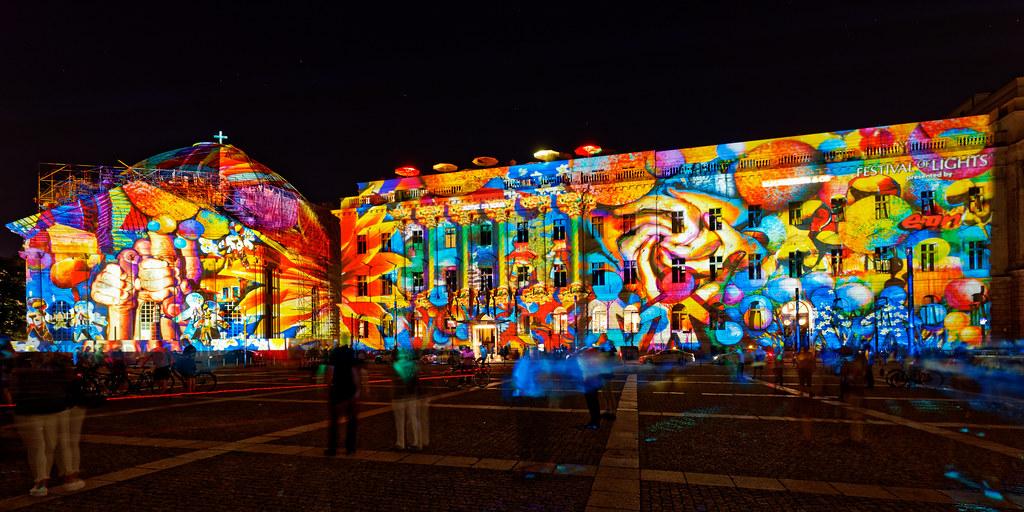#Behrenstraße
Video
Kawasaki Z900 ABS by Pascal Volk
Via Flickr:
"A True Supernaked Experience"
#Behrenstraße#Berlin#Berlin Mitte#Europe#Germany#Mitte#Kawasaki#Z900 ABS#Motorrad#Motorcycle#motorbike#Motocicleta#Naked Bike#Motocicleta naked#Color Key#Selective Color#Green#Grün#verde#standards#Wide Angle#Weitwinkel#gran angular#WA#WW#Sommer#Summer#Verano#Canon EOS R3#Canon RF 28-70mm F2L USM
32 notes
·
View notes
Text
Russia's 2024 Presidential Election Day in Germany

Unter den Linden on the eve of Russian-Berliners' election day. The Navalny memorial is at the left, the Ukraine war memorial at centre, and in the background the quadriga of Brandenburg Gate is silhouetted against the setting sun. Photo by me. All rights reserved.
Russia's presidential elections this weekend were full of no surprises. Vladimir Putin was designated President for another 6-year term, after years of whittling away any rivals for the role.
Freedom in the World Report
- 2015: Retroactively for 2014, Russia was ranked 'Not Free' with 23 points.
- 2023: Russia is still ranked 'Not Free,' with 13 points.
The Freedom in the World Report is released annually by the Freedom House organization, which is based in the United States. The Russian member of parliament Sergei Markov disputed its findings around 15 years ago.
On the ground in Berlin, there were however a few surprises. Ballots were opened there on Sunday.
At around 9:45 a.m., voters had formed a line over 200 metres long, along a building belonging to the largely state-owned Russian airline Aeroflot, where it flanks the Glinkastraße.
The line then turned a corner and went on to a rear entrance of the Russian embassy. A few onlookers filmed the scene with their smartphones and a police van was posted at the Mauerstraße, but no journalists appeared to be there.
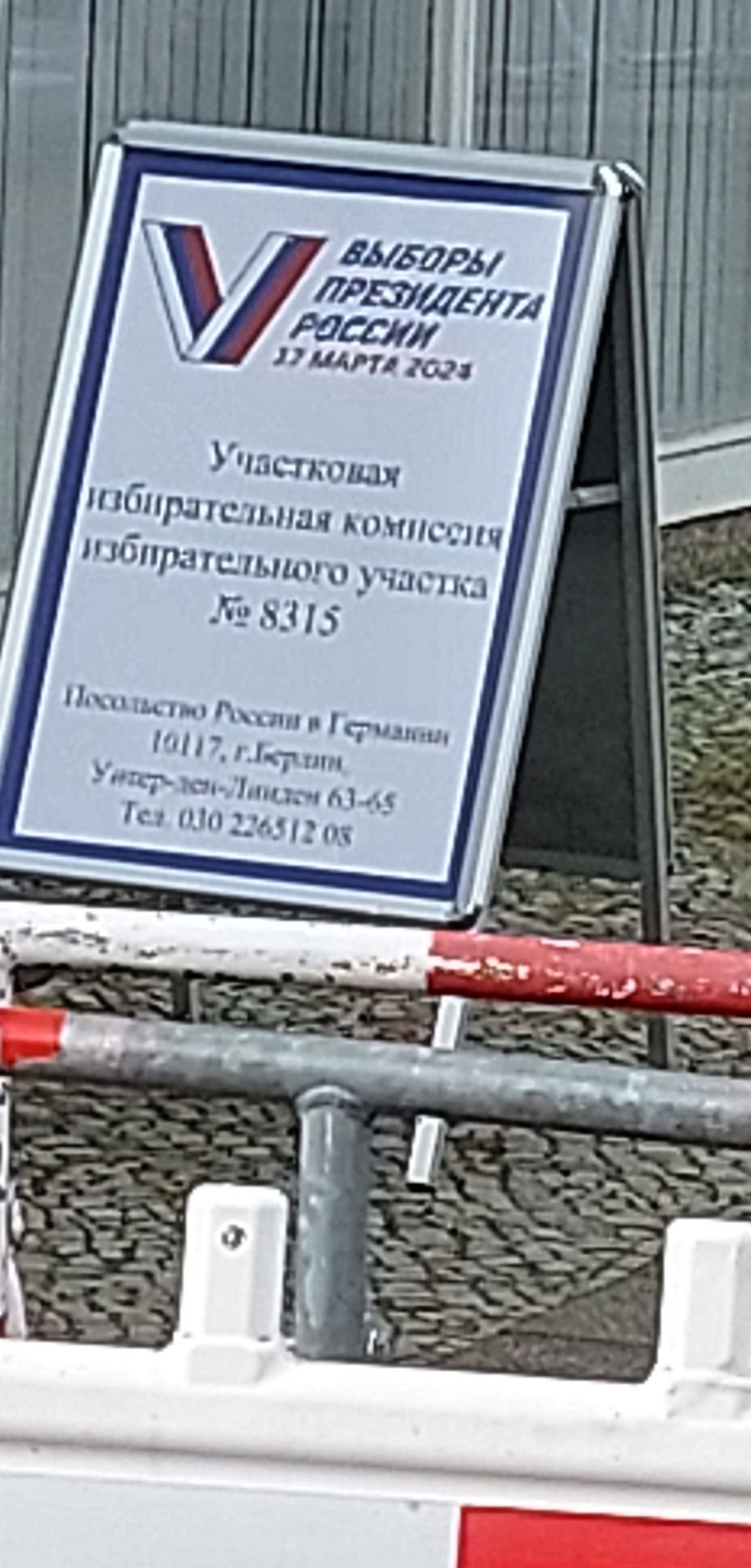
Collapsible sign for the Russian elections in Berlin, set up in front of the Aeroflot building at Unter den Linden, just past the white and red fence where security checks were occurring. March 17, 2024. Photo by me. Public domain.
At the corner of Glinkastraße and Unter den Linden there was a gap in the security fence. There a tall security guard was scrutinizing documents, like the red passports of Russian citizens, held by people in the line. Then the voters were let through past the Aeroflot building to the formal landscaped yard.
Three lanes of traffic divide the embassy from the linden trees of the iconic Berlin street Unter den Linden.
Under the still leafless trees, both the Ukrainian war memorial as well as the bouquets, candles, signs and portraits in honour of Russia's dissident Alexei Navalny were quiet.
But the white-blue-white flag of Russia's anti-Ukraine-war movement had been draped around a tree trunk.
In the traffic lanes on the other side of the memorials, men were putting finishing touches on a sound stage.
Groups like the Russian Antiwar Committee and the #freenavalny campaign had organized a live event after 12 p.m.
Хватит войны лжи репрессий Путина
— 'Enough with Putin's war of lies and repression' (Google Translate). Banner for 12 p.m. event opposite the Russian Embassy in Berlin
***
At 11:56 a.m., the line of people waiting to vote had stretched further along the Behrenstraße behind Russia's embassy and turned a corner into the Wilhelmstraße. Police officers kept the intersections clear, but taking these into account the line was 800 m long.
On Unter den Linden, the protestors' programme had begun.

In the gravel area, protestors, passersby, and many journalists were photographing a paper mâché bathtub in the colours of the Ukrainian flag. Red paint, symbolizing the bloodshed of Vladimir Putin's presidency, dripped over the bathtub's sides. Inside it, the figure of Putin scrubbed his toe with a brush.
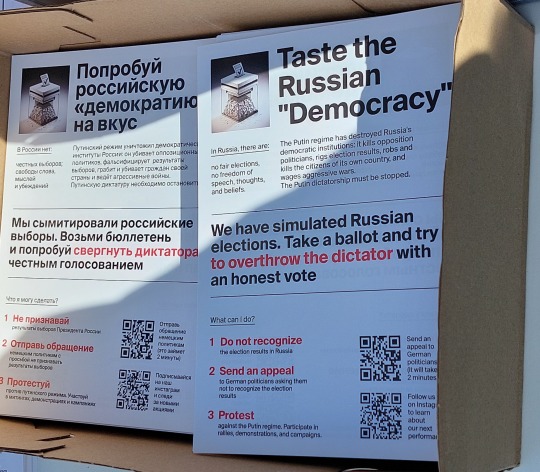
Flyers, Unter den Linden. March 17, 2024. Photo by me. Public domain unless the group that produced the flyers has intellectual property rights.
In front of the bathtub, a group had set up an open air voting experience that they titled "Taste the Russian 'democracy.'"
The ballots, voting booths, and the glass-sided ballot boxes that had a paper shredder fitted at the top, were all detailed parodies. The ballot boxes were even decorated with a formal eagle emblem.
Passersby laughed as they read and filled out the ballots, which were handed out at white tables.
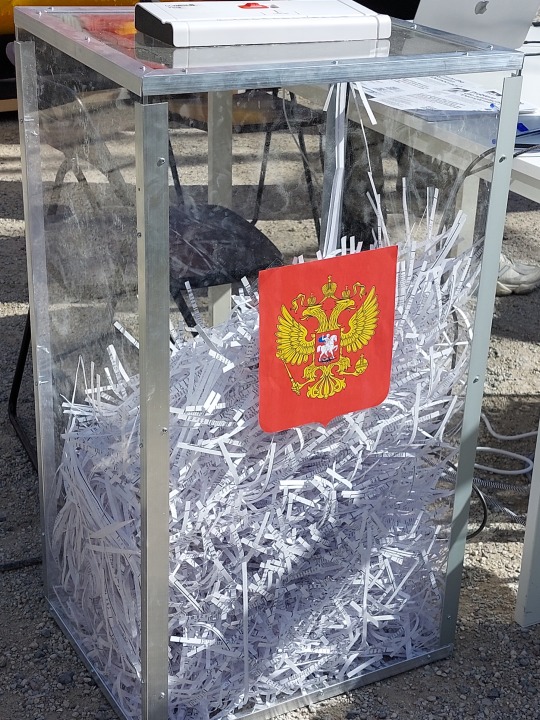
Parody of a Russian ballot box with shredded mock ballots, Unter den Linden, March 17, 2024. Photo by me. Public domain.
Then they watched as a mock election helper reduced their so-called votes to paper strips through the ballot boxes.
The #freenavalny campaign had also set up tables with posters and other papers.
Protestors and visitors at the scene carried protest signs or the white-blue-white antiwar flag.
One sign said, "Even if you have an election today, you still face a tribunal." Another sign suggested that Vladimir Putin should be in the Hague.
Putin is a killer
Not a president
He will not stop
— Protest sign, Unter den Linden, March 17, 2024

Protest sign, March 17, 2024. Berlin. Photo by me. All rights reserved.
Defiantly, protestors set up an unofficial street sign with the name "Alexej-Nawalny-Straße."
As well as a petition that has gathered thousands of signatures, Russian protest groups in Berlin also organized a protest on March 6 asking local Berlin authorities to rename the Behrenstraße in honour of Navalny.
*
The scene on Unter den Linden was loud.
Speakers in Russian and German, from groups like the Free Russia Foundation, had begun to address the crowd from the stage in the northern lanes.
The Berlin city politician Ario Mirzaie, of the Green Party, also spoke. He began by telling the crowd that his parents, too, had come from a "dictatorship": Iran.
The crowd chanted slogans like, "Putin ist nicht legitim!" (Putin is not legitimate) in both languages.
Mikhail Khodorkovsky, who had been imprisoned for years and is now in exile in the UK, would appear later.
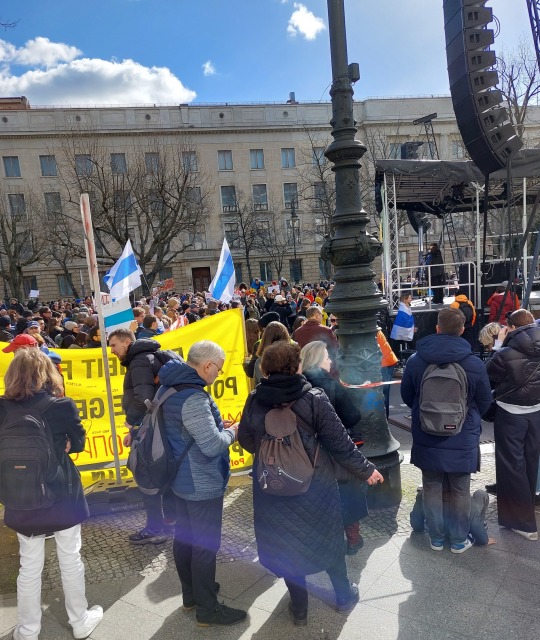
Protestors at the stage for the 12 p.m. "Хватит войны лжи репрессий Путина" event opposite the Russian Embassy in Berlin. March 17, 2024. Photo by me. All rights reserved.
*
The Germany-based group Demokrati-Ja had also set up a wall of banners to draw attention to 'Putin's hostages' ("Putins Geiseln").
* Vladimir Kara-Murza, politician. Arrested in 2022 on charges of making treasonous statements about the invasion of Ukraine.
*Aleksandra Skochilenko, artist. Imprisoned in 2023 on charges of 'disseminating false information' — protest material against the invasion of Ukraine.
*Lilia Chanysheva, politician and associate of Alexei Navalny. Imprisoned in 2023 on charges of extremism. Olga Smirnova, architect and activist. Saurifa Sautijeva, museum staff and protestor. Viktor Shur, artist arrested in 2014 for insulting a police officer and later accused of working with Ukrainian intelligence services. Sarema Musayeva, mother of two activists. Irina Navalnaya, resident of Mariupol accused of terrorism.
(Note: This reporter anglicized the German transliterations of some names above. There may be mistakes.)
*
On the streets south of the Russian embassy, the lines of voters were becoming longer and longer.
Since all the presidential candidates on the ballot were allies of Vladimir Putin, the Russian opposition had encouraged voters across Russia to show passive resistance by appearing at the polls at noon.
In Berlin, hundreds of voters did so.
Before 1 p.m., the line peaked at around 1.3 km, counting the intersections. The Glinkastraße up to Behrenstraße, the Behrenstraße up to the Wilhelmstraße, and the Wilhelmstraße up to the Voßstraße. The line reached up the Gertrud-Kolmar-Straße to the Hannah-Arendt-Straße, across the street from the Holocaust memorial.
On the Wilhelmstraße, in front of the restaurant Yakoolza, a young woman who was standing in line estimated she'd been waiting 45 minutes. At the corner of Wilhelmstraße/Voßstraße, another woman said 1 hour.
At the Hannah-Arendt-Straße, two men, who appeared to be Germans, stood at a street sign. They told the Berlin police officers who were guiding the voter line that they were not eligible to vote. But one of them held a handmade cardboard poster with the words "Stop Putin."
Another man who had been standing in line with the Ukrainian flag on a long pole, left shortly after this reporter had arrived.
*
A voter whom this reporter did not see was the widow of Alexei Navalny, Yulia.
She cast a ballot, then approached the press on her way out of the embassy to explain her write-in vote, for her late husband.

Flowers at the improvised Navalny memorial. Unter den Linden. Photo by me. March 9, 2024. All rights reserved.
0 notes
Text

Die Kunst am Bau / 27.06.2021
#Berlin#Berlin Mitte#Glinkastraße#Behrenstraße#DDR Architektur#GDR Architecture#Ostmoderne#Baubezogene Kunst der DDR#Kunst der Bau#Fritz Kühn#2021#2021Juni#2021Juni27
3 notes
·
View notes
Photo

Komische Oper Berlin 2019
6 notes
·
View notes
Photo

Commercial Building in Berlin, Behrenstraße 22. Arch. Christeller and Sonnenthal. ca. 1910s
79 notes
·
View notes
Photo
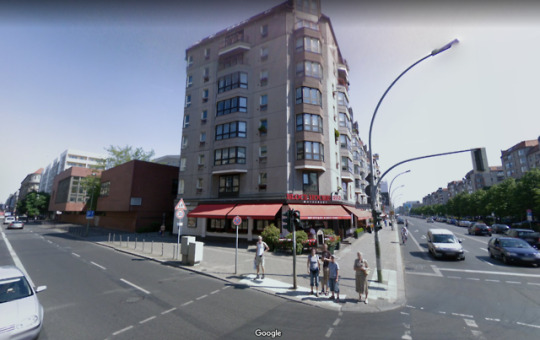
Behrenstraße II Archivbild von Google:
0 notes
Text
NOCHES BERLINESAS

Un corresponsal del Daily Mail describe de la siguiente forma la vida nocturna de Berlín durante la presente crisis por la que atraviesa Alemania:
“El primer lugar que debe ser visitado es “La Mascota”, en la Behrenstraße, el mejor restaurante y el más alegre de la capital. La hora conveniente para ir a comer es de las ocho y media a las nueve de la noche. El salón es amplio, se halla muy recargado de adornos. En el centro hay un lago en miniatura con fuentes, en las cuales se bañan ninfas de mármol de teutónica corpulencia. Aparte de los de Nueva York, no existe ningún restaurante tan costoso como éste, y, con seguridad, no hay en el mundo otro tan antipáticamente deprimente. Una orquesta de zíngaros, con fracs rojos, izada en una tribuna, toca el Vals del Destino, Tipperary, Tannhauser y Yankee Doodle. El correcto jefe de comedor, que antes lo había sido en el Waldorf Astoria de Nueva York, se adelanta a la mesa y se inclina para oír con atención vuestra demanda.
- ¡Ah! – exclama – las cosillas prohibidas no figuran en la lista. Hay entremeses, sopa de tomate, lenguado, filete a la Chateaubriand con patatas saltadas, queso, frutas secas, café legítimo y licores. El precio de dos cubiertos importa trece libras. Esto – añade – no debe referirse a los periódicos. Es demasiada comida. A los pobres no les agradaría.
A las once de la noche el jefe de comedor señala al parroquiano el camino que conduce a la “Gruta de la Medianoche”, en el Palacio de la Danza. Los establecimientos se comunican entre sí. Sí coméis espléndidamente y sois generoso en el gasto en “La Mascota”, tenéis entrada libre en el Palacio de la Danza. Vuestro guía os descubrirá una mesa en la línea frontera, inmediata al escenario, y colocará sobre ella una botella de champagne alemán de cincuenta chelines.
Desde vuestro asiento podéis complaceros en el espectáculo del tango, del vals, del foxtrot y otros bailes. Las presentaciones no son necesarias. Os ponéis delante de la mujer que más os agrade, os inclináis solicito y después de oír de su boca si, la cogéis por la cintura y os lanzáis entre los alegres y pocos refinados danzantes. Las mujeres hermosas no abundan; pero abundan las mujeres.
A la una se ofrecen a los visitantes diversas alternativas: el casino – en el extremo oeste – o el pequeño Hall de la Danza, “danza intima”. Allí imperaba la misma alegría de antes de la guerra. En los clubs de juego se amontona el dinero con más descanso que en Montecarlo. Las cantidades no bajan de cien mil marcos. La mayor parte de los billetes presentan frescura tan sospechosa que la tinta casi los mancha cuando se ponen en contacto con los dedos. Cuando la suerte favorece a la banca se suspende el juego por espacio de media hora hasta que surgen nuevos billetes, que no se hallan registrados en el Reichsbank. Nadie pone atención en ello.
La mayoría de los concurrentes son rusos. Algunos viejos junkers están de pie, serenos, inmóviles, mirando insolentemente a través de sus monóculos, junto a los burgueses enriquecidos con los beneficios de la guerra. En los buffets y en los pequeños salones de baile el abandono continúa hasta rayar el amanecer. A veces, en el exterior, se oyen disparos de armas de fuego, sin que la gente se preocupe. La música resuena por todas partes, tocando el vals favorito, el “Vals del Destino”, suave, lento, dulce, trágico. Berlín danza sobre un volcán, pero no le importa” – El Comercio, martes 1° de julio de 1919, edición de la tarde, página 3
1 note
·
View note
Photo
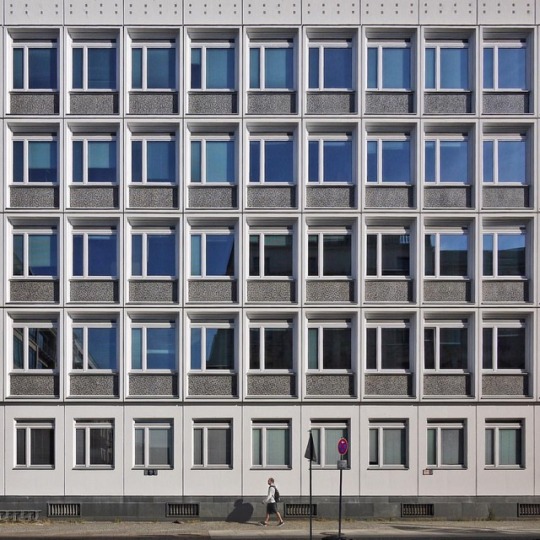
#strideby in Berlin w/ @seojmi . #architecture #Berlin #StoptheRocInBerlin (at Behrenstraße) https://www.instagram.com/p/Bsn97-xHbU0/?utm_source=ig_tumblr_share&igshid=vtfare8c22yk
15 notes
·
View notes
Text
zuweilen unterbrochen
Nun endlich löste sich 1827 die Plamannsche Anstalt auf. Nach langen Jahren konnten ich und Bernhard dieses schreckliche Institut verlassen. Die kommenden drei Jahre besuchte ich das Friedrich-Wilhelm-Gymnasium, welches sich ebenfalls in Berlin befand. Berlin, ich durfte immer noch nicht wieder in mein geliebtes Zuhause. Das Heimweh zehrte schon die vergangenen Jahre an meiner armen Seele. Die Behrenstraße Nummer 52 wurde unser neues Heim. Waren die Eltern nicht da, wurden wir von einer Haushälterin, der lieben Trine, die aus Schönhausen gekommen war, verpflegt. Dort waren außerdem Hauslehrer, die uns auch nach der Schule in den Fremdsprachen unterrichteten.
Am Friedrichs-Gymnasium absolvierte ich nun meine Untersekunda. Für die Obersekunda wechselte ich 1830 auf das Gymnasium zum Grauen Kloster. Bernhard begann zu studieren, weshalb die Wohnung aufgegeben wurde. In dieser Zeit zog ich zu verschiedenen Lehrern meiner Schule.
In der Schule war ich stets unruhig. Ich mochte es nicht wie die Lehrer mit mir umgingen, sie führten sich auf wie meine Vorgesetzten. Das waren sie nie und wurden sie nie. Auch der Lernstoff machte mich nicht immer glücklich. Griechisch hatte es mir nicht angetan, wohingegen Französisch und Latein mir durchaus nützlich und interessant vorkamen. Die Naturwissenschaften, Geschichte und Geografie konnten ein solches Interesse nicht bei mir wecken.
Ostern 1832 erhielt ich mein Abiturzeugnis. Meinen Fleiß beschrieb man in diesem als zuweilen unterbrochen, die Anwesenheit als verbesserungswürdig. Meine Eigenwilligkeit erkannte man, lobte dennoch mein Selbstbewusstsein und meine sprachliche Gewandtheit. Ich erhielt die Gesamtnote zwei.
Ich ging als Pantheist, als Republikaner. Doch sollte das nur der Drang sein, sich von meinem Elternhaus abzusetzen?
Das Gymnasium zum Graue Kloster existiert noch heute. Seine Geschichte kann unter diesem Link betrachtet werden: https://www.graues-kloster.de/index.php?article_id=9.
0 notes
Text
Komische Oper Berlin Building: REX
Komische Oper Berlin Building Project, German Architecture News, Images
Komische Oper Berlin Design
28 Oct 2020
Komische Oper Berlin
Architect: REX
Location: Berlin, Germany
Komische Oper Berlin Expansion
South Facade Render:
image : Luxigon
Rehearsal Stage Render:
image : Luxigon
North Facade Render – one of two rehearsal stages, louvers open:
image : Luxigon
Box office and restaurant on Unter den Linden
This proposed design for the Komische Oper Expansion aspires to create a respectful and individual partner that
highlights the Komische Oper building and defines a new urban node befitting the significance of the institution. Its
contextual massing, outward-facing public functions, and generous urban plaza integrate the building in the
neighborhood’s fabric. Its understated yet dynamic façade allows the Expansion’s creative energy to spill out into the
public realm or be fully cloistered when desired.
04_REX_KOB_Nucleus Diagram
A compact Nucleus: efficient rehearsal node and dynamic performance venue
The Komische Oper Expansion condenses its essential functions into a dynamic ‘Nucleus:’ the two rehearsal stages, the
orchestra rehearsal, and the suite of practice rooms straddle a central ‘Circulation Hub’ containing passenger and scene
elevators, stairs, and lounges for the fluid movement of performers, scenery, instruments, and equipment. This compact
organization renders the Nucleus a highly efficient rehearsal node and—due to the variable raked floor machinery in the
rehearsal stages—a lively public performance venue, able to also host private functions for increased economic
productivity.
05_REX_KOB_Connectivity Diagram
Direct connectivity with the Komische Oper
The Nucleus’ Circulation Hub connects performers and technicians—as well as rehearsal and other support spaces—
directly to the existing Komische Oper’s main stage and orchestra pit. The larger rehearsal stage is adjacent to the side
stage entrance, allowing set configurations to be tested and transported without disrupting other functions. The new
orchestra rehearsal and instrument storage are aligned with the orchestra pit, ensuring timely turn-over from preshow
uses.
06_REX_KOB_Site Requirements Diagram
Preserved site requirements and Komische Oper primacy
In addition to maximizing connectivity with the existing Komische Oper, the Nucleus’ compactness preserves the required
loading and egress alleys while maintaining the critical 20-meter-wide footprint of the rehearsal stages. Performer and
staff access to the Komische Oper Expansion is off Glinkastraße to retain primacy of the Komische Oper’s distinct
entrance on Behrenstraße, both as the public access point for audiences and as a cultural landmark in Mitte. The existing
performer entrance to Komische Oper in the rear courtyard is improved with a new security vestibule adjacent to—and
with security oversight of—the Expansions’ scene dock.
07_REX_KOB_Urban Activators Diagram
Urban activators inside and out, and deferential massing
The Nucleus’ compactness also enables urban activators to cap its ends. On Behrenstraße, the three stacked floors of the
café provide views both out to the city and into the larger rehearsal stage. A new public plaza—the ‘Urban Room’—in front
of the café supports outdoor dining and can serve as an exterior venue for performances, exhibitions, markets, fashion
shows, or cinema.
On Unter den Linden, the new box office, shop, and restaurant increase the Komische Oper’s visibility
on this popular thoroughfare. Like the café, the restaurant—with its own, dedicated entrance for independent operation—
allows guests to watch the rehearsal activities in the smaller rehearsal stage. As these public uses will draw in foot traffic,
they also create new patron engagement with Komische Oper’s programming and support non-performance revenue
streams.
When the rehearsal stages serve as public performance spaces, patrons access these venues from the entrances of the
café and restaurant such that clear demarcation between public and private functions is maintained; portions of the café
and restaurant become the venues’ lobby and bar spaces.
The Expansion lines up strategically with the back of Komische Oper’s entry block to preserve the important sightlines to
its historic entrance, and maintains the loading alley as a passageway under the extension.
Integrated yet isolated office and mechanical functions
The offices, instrument storage, and mechanical spaces are organized in long bars above and below the Nucleus and the
new urban amenities, stretching to the site’s full 110 m. The office floors feature double-story courtyards that introduce
daylight and fresh air into the work spaces. They can be used year-round thanks to deployable EFTE pillows.
The office floors create a 20-meter-long cantilever on Behrenstraße that defines the Urban Room. At almost 15 m high, the
cantilever frames views to the Komische Oper from the corner of Glinkastraße and Behrenstraße, further enhancing the
respectful symbiosis between the two buildings. A similar 10-meter-long cantilever (creating the glass-enclosed box office
below) on Unter den Linden extends the Opera Support Building’s covered public walkway.
Visual, acoustic, and environmental performance
The Expansion’s double-skin façade with its integrated stone louvers (matching the white Cottaer Sandstone to be
reinstalled on the existing Komische Oper) is one of the building’s most notable features, visually and sustainably. The
3 m to 4.2 m tall arced louvers rotate 180 degrees to track the sun, but also give performers the options to 1) expose their
work—as desired—to passers-by, 2) benefit from rehearsing in full daylight, with minimized brightness and glare, or 3)
create full blackout environments. The façade’s ever-changing nature gives the building its subtle yet dynamic identity.
Each facade’s two glazing layers, the naturally-ventilated cavity between them, and their enclosed, stone sun/glare-control
louvers, combine to significantly reduce the building’s mechanical and electrical loads. The double-skin/air cavity mitigates
the fluctuations of external temperatures and creates a chimney stack effect which naturally ventilates the cavity. When
the stone louvers are rotated perpendicular to the sun, daylight reaches deep into the building, reducing electrical loads
and warming up the structure’s floors and walls for passive heating.
The façade’s external glazing layer is comprised of heat-curved, laminated, uncoated low-iron glass panels that are prebonded to extruded aluminum interlocking cassettes, affixed to top-hung steel “T” profiles providing a minimal
appearance. The internal glazing layer is composed of double-glazed, heat-curved, low-iron safety glass units with a
triple-silver low-E coating on surface 3; it is installed similarly to the external laminated panel with a pre-glazed aluminum
assembly and steel “T” profile. The aggregate window-wall U-value is 0.70 W/m2K with a high SHGC of 0.20 for solar heat
gains in winter.
The glass façade system plays a significant role in the Expansion’s acoustic performance:
• the double façade isolates the rehearsal stages, orchestra rehearsal, practice rooms, public programs, and offices
from street noise;
• the stone louvers allow the rooms to reveal themselves and the activity within them without impacting their
acoustic integrity;
• the mass and integral damping of the 20 mm glass inner lite in the insulating glass system contribute acoustic
warmth and mitigate brightness often associated with glass when it is used as an acoustic finish;
• and the curved glass provides acoustic diffusion and—working together with the technical catwalks in the
rehearsal stages—acoustic support for the performers.
Spanning each of the office’s five courtyards is an operable frame mounted with ETFE pillows. The frame is attached to
tracks that allow the operable roof to slide open making the courtyards a year-round amenity for staff. When closed, the
frame is designed as a fully gasketed, thermally broken system and acts as the courtyard’s thermal line. The air-inflated
panels improve U-Value thermal performance and, through printed patterns, can reduce the SHGC as required.
The entire façade is suspended from the roof to protect it from variable slab movements and minimize horizontal joints
along the glazed surface.
At the corner of Behrenstraße and Glinkastraße, the Urban Room under the Expansion’s cantilever adds a dynamic public
plaza to the Komische Oper complex and Mitte. This ever-changing public square serves both as an outdoor seating area
for the café and as an event space for exhibitions, performances, markets, fashions shows, or cinema. In addition to
attracting new patrons, the versatility of this space offers the Komische Oper a different source of revenue through
institutional partnerships, further ensuring its social and economic sustainability.
Three closed concrete cores at the center and at both ends of the Expansion compose its primary structural system.
Besides functioning as the main vertical support elements, the rigid cores also absorb lateral movement, induced primarily
by wind loading. All generic, non-isolated floor slabs are supported by a combination of the cores and concrete columns;
except for the conventional concrete slab on the ground floor, they are Holorib to achieve high efficiency and weight
reduction.
At the top two floors—the offices—four parallel, double-height trusses span the building’s full length, a continuous beam
working with the concrete cores to form the 20-meter-long cantilever hovering above the Urban Room and the 10-meterlong cantilever over the box office.
Floating above the generic slabs and below the top floor trusses, all the rehearsal spaces employ a box-in-box concept,
providing optimal sound and vibration isolation amongst the rooms and from the superstructure.
The rehearsal stages and orchestra rehearsal are constructed as independent boxes resting on isolators and attached
laterally to the primary superstructure using acoustic wall ties. The larger rehearsal stage and orchestra rehearsal boxes
are built using various combinations of conventional and prestressed precast concrete floor/ceiling slabs, precast walls,
and steel trusses, while the small rehearsal stage box is composed of a precast concrete slab and plasterboard
walls/ceilings. By contrast, the practice room boxes—composed of wood floors and plasterboard walls/ceilings—are
resiliently supported on a conventional concrete slab suspended by hangers from the office trusses.
The Expansion adopts several sustainable strategies, including a naturally-ventilated façade, optimized building systems
(displacement ventilation; plenum air distribution; high-efficiency, sensible, and latent heat recovery units and lowpressure air ducting; radiant thermal systems; geothermal ground source system), photovoltaic modules, green roof, and
open space.
Natural ventilation at the office levels is provided via the passively tempered courtyards, which are thermally closed in
winter with triple layer ETFE pillows that can be opened in the intermediate and summer seasons. This creates semi-open
planted buffer spaces, ranging from a minimum annual temperature of 12°C in winter to shaded ambient temperatures in
summer for full use as breakout and recreational spaces. The courtyard facades are single glazed for optimal daylight
quality and natural ventilation for the offices. A textile shading system below the ETFE pillows helps control daylight, glare,
and temperature.
Komische Oper Berlin Expansion – Building Infromation
CLIENT: Federal State of Berlin, Senate Department for Urban Development and Housing
PROGRAM: Renovation and expansion of a landmarked opera house, including two rehearsal stages, orchestra
rehearsal, suite of smaller practice rooms, box office, shop, café, restaurant, and administrative offices
AREA: 38,000 m2 (409,000 sf)
COST: Confidential
STATUS: Limited competition 2020; finalist 2020
ARCHITECT: REX
PERSONNEL: Tim Carey, Wanjiao Chen, Adam Chizmar (PL), Maur Dessauvage, Kelvin Ho, Sebastian Hofmeister (PL),
Britt Johnson, Isabelle Moutaud, Joshua Ramus, Elina Spruza Chizmar, Tammy Teng, Vaidotas Vaiciulis (PL), Teng Xing
LOCAL ARCHITECT: Brenne Architekten
CONSULTANTS: Front, Jan Knippers, KLW, Theater Engineering, Theatre Projects, Threshold, Transsolar, Treibhaus
BKomische Oper Berlin Building design by REX images / information received 281020
Location: Berlin, Germany, western Europe
Architecture in Berlin
Contemporary Architecture in the German Capital
Berlin Architecture Designs – chronological list
Berlin Architecture Walking Tours
New Media Campus for Axel Springer in Berlin
Design: BIG + Bollinger+Grohmann + Man Made Land +Topotek 1 + Kardoff Ingenieure + Wenzel+Wenzel
image by architects
Media Campus Axel Springer
Berlin Buildings
Berlin Architects
Jewish Museum Berlin
German Architecture
German Architects
Berlin Architecture
Comments / photos for the Komische Oper Berlin Building design by REX Architecture page welcome
Berlin
The post Komische Oper Berlin Building: REX appeared first on e-architect.
0 notes
Video
15. St. Hedwigs Kathedrale und 16. Hotel de Rome by Pascal Volk
#Festival of Lights#Berlin#Mitte#Bebelplatz#Berlin Mitte#Rocco Forte Hotel de Rome#Behrenstraße#St. Hedwigs-Kathedrale#Bischofskirche#St. Hedwig's Cathedral#catedral de Santa Eduvigis#Berlin illuminated#Nacht#Night#Noche#Wide Angle#Weitwinkel#gran angular#super wide angle#Superweitwinkel#ultra wide angle#Ultraweitwinkel#ww#wa#sww#swa#uww#uwa#17mm#Herbst
1 note
·
View note
Photo

Mitmachen beim weltweiten Klimastreik
WeMove #unteilbar - #aufstehen #allefuersKlima !
Vom Fernsehen sind wir Wiederholungen gewöhnt - machen wir selber mal eine:
Wie genau vor einem Jahr rufen wir gemeinsam mit Fridays For Future, Gewerkschaften, Kirchen, Sozial- und Umweltverbände, den Grünen und der Linken wieder für einen Klimastreik auf.
Wegen der Corona-Einschränkungen werden es nicht die Hunderttausende wie im letzten Jahr werden, aber in vielen Städten werden Menschen auf die Straße gehen und wirksame Maßnahmen für unser Klima fordern.
Wie das Umweltinstitut München schreibt, liegt gegenüber vorindustrieller Zeit der Anteil an CO2 in der Atmosphäre heute um fast die Hälfte höher. Das bleibt nicht ohne Konsequenzen: Seit 1881 ist es global bereits im Mittel um rund 1 Grad wärmer geworden. In Deutschland sogar um 1,5 Grad. Die Folgen sind daher auch bei uns spürbar. In nahezu ganz Deutschland herrscht eine schwere Dürre. Ein neues Waldsterben droht . - das sieht man bei jedem Spaziergang im Wald oder Park. Damit die Erderhitzung nicht aus dem Ruder läuft, muss die Politik endlich die nötigen Maßnahmen ergreifen, um die Treibausgas-Emissionen schnell und drastisch zu reduzieren.
An diesem Freitag beim Klimastreik wird auch die Berliner Friedensbewegung dabei sein und auf die immer noch unterschätzte Rolle, die Kriegsvorbereitung und Krieg für die Zerstörung unseres Klimas spielen, aufmerksam machen. Die Friko Berlin trifft sich um 12 Uhr auf dem Pariser Platz vor der Akademie der Künste.
Die Größenordnung der Umweltverschmutzung durch das Militär hat Greenfinder in einem Artikel so berechnet: "Über den größten Umweltverschmutzer der Welt wird selten gesprochen: Er ist das Militär des US-Imperiums. Die gigantische Kriegsmaschinerie ist der weltweit größte Verbraucher von Erdölprodukten. Offiziell werden auf den weltweit ungefähr 1.000 Militärbasen täglich 320.000 Barrel Öl verbraucht. Sie verursacht die meisten sogenannten Treibhausgasemissionen und schleudert Tag für Tag megatonnenweise giftige Schadstoffe in die Umwelt." Die Baseler Zeitung kommt auf 269.000 Barrel Öl am Tag und sieht das US-Militär bei den Verschmutzern durch flüssigen Treibstoff direkt hinter der Schweiz und vor mehr als 140 anderen Staaten. Die Zeitung schreibt auch, wie schwierig es ist an verlässliche Zahlen zu kommen, denn diese waren nur über die US Defense Logistics Agency (DLA), einer bisher wenig untersuchten Behörde innerhalb des amerikanischen Verteidigungsministeriums zu erhalten.
Auf Gegenfrage.de lesen wir über die "Entsorgungslösungen" des Militärs: "Zudem werden ausgemusterte Schiffe samt hochgiftiger Ladung zumeist nicht fachgerecht abgebaut und entsorgt, sondern auf hoher See einfach mit Torpedos und Raketen bombardiert und versenkt. Mindestens 109 Mal soll dies zwischen 1999 und 2012 so praktiziert worden sein. Nur 64 Schiffe wurden im selben Zeitraum verschrottet und recycelt."
"Was kostet es, die ganze Welt zu ernähren?"
Darauf kann man einfach antworten: "Gerade einmal ein Drittel von dem, was es kostet, sie zu zerstören."
In Berlin sind folgende Veranstaltungen geplant
Berlin, 11:00 Uhr, Washingtonplatz (Fahrraddemo) Mehr Infos
Berlin, 11:00 Uhr, Behrenstraße/ Eberstraße (Fahrraddemo) Mehr Infos
Berlin, 11:00 Uhr, Brandenburger Tor Mahnwache
Bernau (bei Berlin), 14:00 Uhr, Bahnhofsvorplatz Zubringerdemo nach Eberswalde
... und viele weitere in anderen Städten ...
Mehr dazu bei https://fridaysforfuture.de/
und https://www.aktion-freiheitstattangst.org/events/2785-20200925.htm
und https://www.aktion-freiheitstattangst.org/de/articles/7400-20200924-mitmachen-beim-weltweiten-klimastreik.htm
0 notes
Photo

Das Stadtgrün. / 09.01.2021
1 note
·
View note
Photo

Behrenstraße #Berlin (hier: Behrenstraße) https://www.instagram.com/p/CBWQdm1Fx1W/?igshid=w2hhxisynvxb
0 notes
Photo
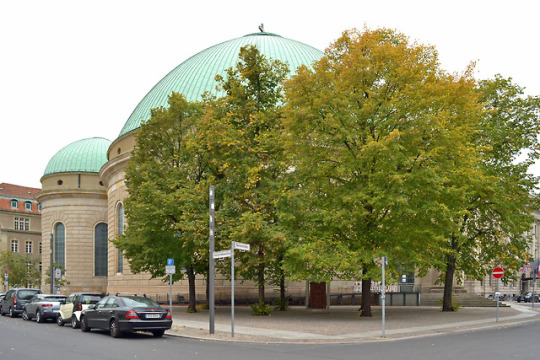
Behrenstraße / Hinter der Katholischen Kirche 2018
6 notes
·
View notes


